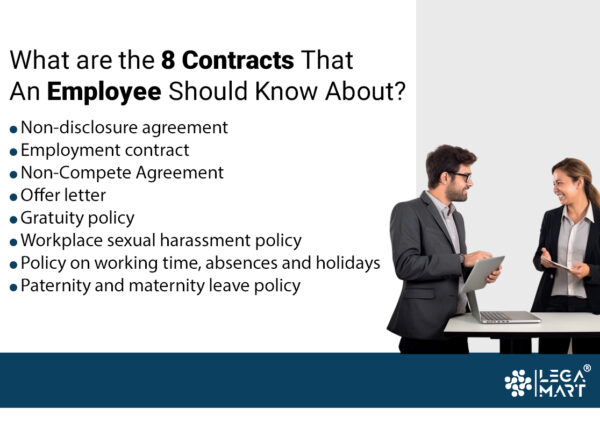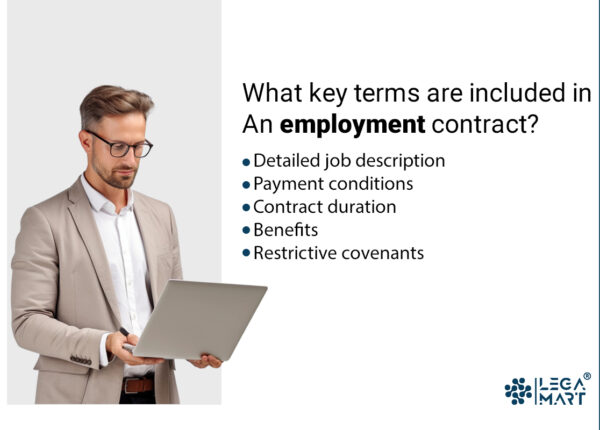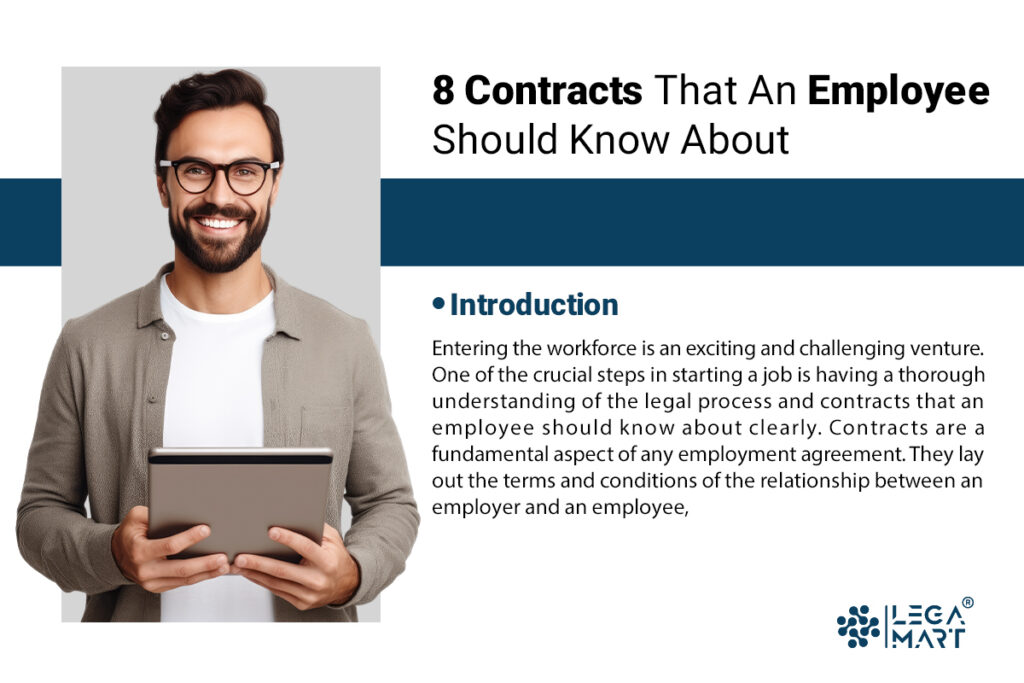Introduction
Entering the workforce is an exciting and challenging venture. Within the field of Legal Practice & Specialization, one of the crucial steps in starting a job is having a thorough understanding of the legal process and contracts that an employee should know about clearly. Contracts are a fundamental aspect of any employment agreement. They lay out the terms and conditions of the relationship between an employer and an employee, and they also help ensure that both parties understand their rights and responsibilities. Therefore, employees must know the contracts required to ensure familiarity with their responsibility and obligation. This article will give you brief information about contracts an employee should know about.
What are the 8 contracts that an employee should know about?

If you are confused about which contracts to prioritize among many agreements under employment law, here is the list for you, which includes:
Non-disclosure agreement
What is a Non-Disclosure Agreement (NDA)?
A non-disclosure agreement (NDA) is a legally enforceable contract establishing a personal connection between two parties. The person or parties signing the agreement agree that any sensitive information obtained or intellectual property will not be shared with anyone else. An NDA is also known as a secrecy agreement under employment law.
Non-disclosure agreements are prevalent when firms negotiate with other businesses. They let the parties exchange critical information without worrying about it falling into rivals’ hands. In this scenario, it is referred to as a mutual non-disclosure agreement.
Understanding Non-Disclosure Agreements (NDAs)
The NDA is valid in several situations. First, NDAs are typically necessary when two firms explore doing business together but wish to protect their interests and the specifics of any possible arrangement. In this scenario, the language of the NDA prohibits all parties involved from disclosing anything about the other party’s or parties’ business procedures or goals.
Some businesses also ask new workers to sign an NDA. For example, suppose the employee has access to critical confidential information. Some organizations will need all workers to sign the agreement; others will require only specific departments or groups of employees to sign the deal.
What are some benefits of NDAs for employees?
The fundamental advantage of an NDA is that critical information about your firm is kept private. This might include everything from R&D to potential future patents, money, negotiations, etc. Signing an NDA prevents confidential information from becoming public.
NDA agreements are also explicit. To minimize misunderstanding, they explain what can and cannot be shared. NDAs are inexpensive to construct because they are signed pieces of paper.
This is one of the most cost-effective methods of keeping sensitive information private. NDAs also specify the repercussions of exposing restricted material and confidential information, which should help to avoid leaks. Furthermore, NDAs are an excellent way to maintain comfort and trust in a relationship.
What are the Key Elements of Non-Disclosure Agreements?
Non-disclosure agreements (NDAs) are legal contracts that protect confidential and proprietary information from being disclosed by one party to another. The key elements of an NDA typically include the following:
- Definition of confidential information: The NDA should clearly define what information is confidential and protected under the agreement. This can include trade secrets, proprietary information, customer lists, and other sensitive business information.
- Parties involved: The NDA should identify the parties involved, including the disclosing party (the one sharing confidential information) and the recipient party (the one receiving the information).
- Purpose of the disclosure: The NDA should specify the purpose for which the confidential information is being shared, such as to evaluate a business opportunity or for a specific project.
- Obligations of the recipient: The NDA should outline the obligations of the recipient party, such as maintaining the confidentiality of the information, limiting access to the information to only those who need to know, and using the information only for the specified purpose.
- Exclusions from Confidentiality Treatment: It clarifies what information is not covered by the confidentiality treatment. These exclusions may include the following:
- Publicly available information: Information that is already available to the public or becomes publicly available through no fault of the recipient party is typically excluded from confidentiality treatment.
- Information is already known: Information that the recipient party already knew or was already in possession of prior to the disclosure is generally excluded from confidentiality treatment.
- Required disclosures: If the recipient party is legally required to disclose the information, such as through a court order or government mandate, the confidentiality treatment may not apply.
- Independent development: If the recipient party independently develops the same information without using or relying on the confidential information disclosed by the disclosing party, the confidentiality treatment may not apply.
- Duration of the confidentiality commitment: The duration for an NDA may vary depending on the nature of the confidential information and the needs of the parties involved. Duration can be for a fixed period of time, such as a specified number of years, or it can be indefinite.
Employment contract
What is an employment contract?
An employment or employment contract is an employer and employee agreement. Establishing an official working partnership is the legal basis for the two parties under employment law.
“Strategic planning” refers to developing a plan for a specific project. Furthermore, while employing employees, employers will have the employee sign an employment contract outlining the benefits, the employment rights act and considerations provided to the employee.
When a written employment contract is signed, it becomes legally binding. An employment relationship has been officially established under an employment agreement. It is instantly effective if its terms and conditions comply with the law.
Types of Employment Contracts
There are several types of employee contracts that employers may use to formalise the terms and conditions of employment. The most common types of employee contracts include:
- Fixed-term contracts: A fixed-term contract is a type of employment where the relationship between employee and employer is established for a set period, which may be based on a specific task or event. They are often used for temporary or seasonal work.
- Full-Time Employment Contracts: This type of contract typically establishes a long-term employment relationship that provides the employee with a set number of working hours per week, often ranging from 35 to 40. Full-time employment contracts are often considered more secure than other contracts, as they provide greater job stability and benefits. However, they may also require more commitment and offer less flexibility than other types of employment contracts.
- Part-Time Employment Contracts: This agreement is for a limited or reduced number of working hours per week, normally less than 20 hours per week. However, part-time employment contracts may offer less job security and fewer benefits than full-time contracts.
- Zero-hour contracts: These contracts are typically used for work or jobs that are required irregularly. This allows the employer to have workers on standby or “on-call” without any set or predetermined amount of work to be offered. The contract typically requires workers to be available when needed, without any obligation to accept work when offered. In essence, they provide flexibility for employers and workers alike, allowing staffing needs to be met when required while also allowing workers to manage their own schedules.
- Casual contracts: These contracts are used for employees who work irregular hours or on an as-needed basis. They typically offer less job security than permanent or fixed-term contracts.
- Apprenticeship contracts: These contracts are used for individuals who are learning a skilled trade or profession. They typically combine on-the-job training with classroom instruction.
- Freelance or independent contractor contracts: These contracts are used for individuals who provide services to a company as a self-employed individuals rather than as an employee.
What key terms are included in an employment contract?

Employees should pay particular attention to the following provisions before signing the employment contract:
- A detailed job description. This covers the employee’s title and the responsibilities they are expected to do during the contract’s tenure. Duties and responsibilities should correspond to the initial job posting’s job description.
- Payment conditions (compensation). To minimize misunderstandings, the payment term should be included in the contract. The company should define the rate (hourly, daily, weekly) and when and how employees should anticipate remuneration.
- Contract duration. This covers the contract’s terms. Furthermore, this part contains technical information, such as the grounds for termination and contract extension alternatives. Some employers incorporate a trial period as well.
- Benefits. Holiday pay, leave benefits, sick leave, annual leave, health insurance, employee stock options, and any other perks the business provides should be stated. Because some firms mention bonuses in job advertisements, it is critical to be consistent and clear.
- This section contains restrictive covenants. They should be carefully examined because they may impact your future work prospects. Non-compete agreements, non-solicitation agreements, and severance agreements are some examples.
Non-Compete Agreement
What is a Non-Compete Agreement?
A non-compete agreement is a legal contract between an employer and an employee that restricts the employee from engaging in activities that compete with the employer’s business for a certain period after the employee leaves the company. This type of agreement is designed to protect the employer’s business interests by preventing former employees from using knowledge gained while working for the company to compete against it.
It’s important for employees to carefully review and understand the terms of a non-compete agreement before signing it, as it can impact their future career opportunities and ability to work in their field of expertise after leaving the company.
Understanding Non-Compete Agreements
When an employer hires a new employee, they may ask them to sign a non-compete agreement, which gives them control over certain aspects of the employee’s activities even after their employment contract has ended.
The agreement might include clauses that forbid the employee from working for a competitor, regardless of whether they were dismissed or left their previous position voluntarily, even if the new job doesn’t require them to reveal any confidential information. These agreements could specify the duration of the non-compete, the geographic region where the employee is or isn’t permitted to work, or the specific market where they can or can’t work. These agreements could also be known as “covenants not to compete” or “restrictive covenants.”
Non-compete agreements are intended to prevent employees from using information they gained to launch a competing business while safeguarding the employer’s position in the market.
Advantages of Non-compete Agreement
By imposing restrictions on employees working for competitors, non-compete clauses help safeguard a company’s trade secrets and proprietary information. This helps prevent the misuse or unauthorised disclosure of sensitive data that could potentially jeopardise the company’s market position.
Non-compete agreements can also foster innovation among employees who sign them. Non-compete clauses also give employers the advantage of identifying candidates committed to a long-term position. By making it a requirement for employees to sign such agreements, employers can differentiate those seeking only short-term employment from those genuinely interested in pursuing a career with the company.
Furthermore, non-compete agreements can reduce employee turnover, which can be advantageous for employers. Employees aware of the restrictions imposed by non-compete agreements may be less inclined to leave the company for a competitor, leading to a more stable workforce and a reduction in hiring and training costs.
key elements of a non-compete agreement
The key elements of a non-compete agreement typically include:
- Scope of the Restriction: The agreement should clearly define the activities the employee is prohibited from engaging in during and after employment. This may include working for a competitor, soliciting clients or customers of the company, or disclosing confidential information.
- Duration/Timing: The agreement should specify the length of time the non-compete restriction binds the employee. This may range from several months to several years, depending on the nature of the job and the legitimate interests of the employer.
- Geographic Location: The agreement should identify the geographic area where the employee is restricted from working. This could be as broad as an entire country or as narrow as a specific city or region.
- Enforceability: The agreement should specify the circumstances under which the non-compete restriction may be enforced, such as a breach of contract by the employee or the termination of employment by the employer.
- Specified competitors: Some industries may require a highly detailed non-compete agreement that explicitly names the companies where the departing employee is prohibited from seeking employment.
Offer letter
What is an offer letter?
A job offer letter, or “offer letter,” is a formal document that creates an agreement between an employee and an employer. The company sends the employee an employment offer letter to notice and outline the terms of employment. Title, salary rate, perks, and conditions are typical examples of these phrases.
Because the nature of an offer letter and its rules differ from state to state, please consult with an employment lawyer and get legal advice before employing it in your firm.
What’s included in an offer letter?
The letter should include all essential information, including:
- Start date.
- Salary.
- Title.
- Schedule.
- Benefits.
- Supervisor’s name.
- All agreements, such as non-compete, non-disclosure and at-will employment.
wanna know more?! Read Employment Offer: Everything you need to know!
Resignation Letter
What Is a Resignation Letter?
A resignation letter is a formal document that an employee submits to their employer, informing them of their intention to leave the company. It is a professional way to communicate that the employee is ending their employment with the company and may include the reasons for resigning.
What to Include in a Resignation Letter?
A resignation letter should include the following information:
- The date: Including the date when resigning is a crucial element of the letter, as it serves as a record of when the resignation was given.
- Contact information: In the resignation letter, it is important to provide your name, mailing address, phone number, and email address.
- Addressee: Address the letter to your supervisor or manager.
- Statement of Resignation: Clearly state that you are resigning from your position and the date your resignation will take effect.
- Reason for resigning: You may choose to include the reason for your resignation in the letter, but it is not necessary. If you do include a reason, keep it brief and professional.
- Gratitude: Express your gratitude for the opportunity to work for the company and the experience gained while on the job.
- Offer to help: Offer to help make the transition as smooth as possible by offering to train your replacement or complete any necessary tasks before your departure.
- Closing: End the letter with a polite closing, such as “Sincerely” or “Best regards,” followed by your signature.
Read more: Resignation Letter: Everything you need to know
Workplace sexual harassment policy
What is sexual harassment?
Sexual harassment in the workplace is a kind of sex discrimination that violates Title VII of the Civil Rights Act of 1964. The EEOC defines sexual harassment as unwanted sexual approaches, solicitations for sexual favours, and other sexually related verbal or physical actions.
- Submission to such behaviour is a requirement or condition of employment. Depending on the situation, the need could be communicated explicitly or implicitly.
- Acceptance or rejection of the behaviour is used to make job decisions.
- Sexual conduct that has the intention or effect of unreasonably interfering with work performance
There is no denying that the internet has changed the way people communicate.
The goal of the workplace sexual harassment policy
The goal of a workplace sexual harassment policy is to safeguard men and women in the workplace from unwelcome sexual approaches and to provide instructions for reporting incidences. This policy will also express terms and clarify how the firm handles allegations, punishes sexual harassment, assists victims in recouping their losses and disciplinary procedure. This policy applies to all employees, regardless of gender, sexual orientation, level, function, seniority, position, or other protected characteristics. All employees must follow this policy in a corporation.
Read: Harassment, a violation of the fundamental right
Policy on working time, absences and holidays
Definition of policy on working time, absences and holidays
Another contract that an employee should know about is the policy about working hours, absences, and holidays. As an employee, you should feel entitled to the personal time you have earned and not have to fight approval pressures when using it. According to Oxford Economics, six out of ten Americans say their employers discourage them from taking time off. This generates office conflict because employees believe management must be more interested in their personal lives.
An employee attendance policy is written paperwork describing the company’s attitude on taking personal time off and how an employee should seek it. Your organization will have a more sustainable strategy for addressing time off requests if you define a clear employee attendance policy while enabling employees to use their time off.
Your attendance policy is a critical component of your entire business culture, and how you approach it will impact how workers prioritize their professions and personal lives.
Because each employee may have a unique viewpoint when seeking time off, an employee attendance policy offers a clear baseline for both the company and the employee to turn to when resolving difficult or sensitive time off requests. According to the Centers for Disease Control and Prevention, absenteeism cost U.S. companies more than $200 billion in 2015, so having this document on hand will assist in guaranteeing you are getting the most out of your workers while accommodating their requests for time off.
Advantages of policy on working time, absences and holidays
Employees benefit from flexible work hours at the office by avoiding peak-hour traffic commutes, which may decrease fuel expenses and aid the environment. Trying to commute during rush hour might add an hour to your commute time each day. Many employees prefer to set their schedules sooner or later to prevent wasting time that may be spent more productively at home. Another benefit for employees is the opportunity to tailor their program to their personal life, whether fitness or family commitments. The flex schedule gives employees control over their day, making them feel happier about their work environment.
Gratuity policy
Eligibility for gratuity
Employees who have worked for their company continuously for at least five years are eligible for a gratuity. Employees in the public and private sectors are affected by this. The minimum criterion is five years of service, while the qualifying requirements may vary from business to firm.
New rules for gratuity in 2023
On July 1, 2022, the new labour legislation became binding for all companies and organizations. Working hours, the Provident Fund (PF), and the in-hand wage were all decreased in conformity with the new labour legislation. This law will have the most impact on take-home income.
According to the new gratuity policy for 2023, employers must make sure that base pay makes up 50% of an employee’s CTC (cost to the firm) and that the other 50% is made up of overtime, housing expenses, and employee allowances. Additionally, any additional allowances or exemptions paid by the business that exceed 50% of the CTC will be considered compensation.
In the new gratuity policy for 2023, which will increase the gratuity bonus that must be granted to employees, the legislation restricts the maximum basic pay to 50% of CTC. The gratuity will be calculated based on a sizeable base income that comprises a basic salary and benefits.
Employees who work overtime, such as shifts lasting more than 15 minutes, are paid.
Calculation of gratuity
The gratuity amount is determined by the number of years of employment with the company and the most recent income received. The following is the formula for determining gratuity:
Gratuity = (Last drawn salary x Number of years of service x 15) / 26
Paternity and maternity leave policy
Definition of paternity and maternity leave
One type of employee leave is paternity and maternity leave. In addition to various types of time off, employee leave includes absences and medical leaves.
As workers seek a better work-life balance, paternity and maternity leave are becoming more common and in demand. After all, connecting with a newborn is a life experience that most people only experience sometimes. Giving parents a chance to spend time with their child and enjoy it may be a special reward for some.
What’s the difference between paternity and maternity leave?
The policies of most firms that offer paid paternity leave stipulate that leave is available upon the birth or placement of a child in the home, and the laws that require paternity rest also make this clear.
Usually, maternity leave extends through the child’s delivery and includes every stage of pregnancy. However, under the FMLA, expectant mothers can take time off for maternity leave before the baby is born.
The majority of dads receive time off only after. In certain instances, the term “spouse” has taken the role of “paternity,” which implies a male employee, to encompass same-sex couples.
Conclusion
To conclude, employees must know the essential contracts needed at work. By solidly understanding the contracts involved, they can make informed decisions and avoid potential legal issues that could harm them. Understanding contracts is a critical component of being a successful employee, and it is essential to take the time to learn about these agreements before starting a job. In addition to helping employees, being fully equipped with contracts that an employee should know about will help you enhance your knowledge and can protect yourself before any situation.
When considering entering into any employee agreement, it is essential to seek the counsel of an established business attorney. This will allow you to work with an enforceable contract that safeguards you. In addition, accurate knowledge of the advantages of contractual terms and whether a firm should accept particular contractual provisions may be found in the advice of professional attorneys. Or, more simply, you can visit the LegaMart directory and employ a lawyer to grasp all the details you need regarding contracts that an employee should know about based on your questions from your smartphone.
Frequently Asked Questions
Can an employer change the terms of an employment contract?
Yes. An employer can only change the terms of an employment contract with the agreement of the employee or by providing notice per the contract or applicable law.
Can an employee terminate an employment contract?
Yes. An employee may terminate an employment contract by resigning from their position. However, the terms of the contract may include notice requirements or other provisions that must be followed.
Are Non-Competes Really Enforceable?
The enforceability of non-compete agreements varies depending on the jurisdiction and the specific terms of the agreement. In some states or countries, non-compete clauses are not enforceable at all, while in others, they are enforced with certain limitations. Most courts in the US typically look at several factors while determining whether a non-compete agreement is enforceable, including the scope of the restriction, the geographic area covered, the duration of the restriction, and the employee’s role and access to trade secrets or confidential information.




